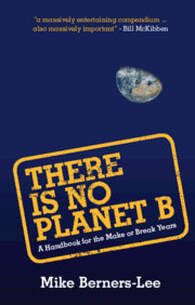There Is No Planet B: A Handbook for the Make or Break Years
This book is more than about climate change. Berners-Lee also mentions the biodiversity crisis, ocean acidification and plastics, to which I would add the global dispersal of man-made synthetic chemicals – the invisible counterpart of the plastics issue.

Published by Cambridge University Press, 2019
He also discusses the human social structures and institutions that have led to these crises, including economics, inequality, business, work, prisons, technology, values, truth and thinking skills. Right at the start of the book he sets out the values that underpin it:
“that all people have equal intrinsic value as human beings” and that “all forms of life matter”. (p.7)
The book is a readable guide which can be read from cover to cover, but it is also a reference work in which information can easily be found. The main text is written in the form of answers to questions and at the end are summaries on the “Big Picture” and “What can I do”, plus an appendix on climate change basics (“the fourteen points that ....every politician needs to understand before they are fit for office”) and an “Alphabetical Quick Tour”. The questions include general ones, such as “Is local food best?” (not necessarily) and “Is fossil fuel better burned or turned into plastic?” (neither, it should be left in the ground). Other questions are about what individuals, businesses or governments should do, e.g. “Should I buy an electric car?” (yes, but only if you really need a car of your own), “How can businesses think systematically?” and “How do our metrics need to change?” Sometimes the answers tend towards the trite, such as telling fishermen not to overfish (p.36) - I would have liked something about the potential for controls over fishing methods to reduce the harm we are doing to ocean ecosystems. Should we ban trawling, for example, rather than focussing on limiting catch sizes? However, this is probably too complex an issue for a book of this breadth, so my criticism is probably a quibble.
The first proper chapter of the book is about food and contains lots of good facts and figures. For example, on average, globally, we consume 180 kcal more food than we need. So there is not a problem with producing enough food, the problem is unequal access to it. Berners-Lee talks about how we can continue to feed the world population as it grows, for example by cutting down on the amount of human-edible crops which are fed to animals (which is currently equivalent to three-quarters of the calorific needs of the human population) and by reducing waste. Aside from livestock, the crop where there is the greatest potential for reducing greenhouse gas emissions is rice: we could save over half a billion tonnes of CO2e per year if rice growers cut down on fertiliser use and did not flood their paddy fields (p. 29-30). Berners-Lee says he has not been able to find a source of sustainable rice, but does not say how far organically certified rice goes towards sustainability; organically-grown rice should at least not use artificial fertiliser. While, globally we produce enough food, production is concentrated in particular regions. In particular, the Americas are net exporters to Africa and Asia (p.150). Will this global system still produce enough if climate change decimates crops in the key producing regions, and will it be able to distribute it to where it is needed if sea level rise put key port facilities out of action?
The chapter on ‘Travel and Transport’ (p. 99) discusses how the distance we have travelled has increased over the years to the point where, today, the average person travels 3921 miles per year. And there is no sign that this will be curbed anytime soon, particularly with investments in things like high speed rail, space tourism and autonomous vehicles. Biodiesel is not the answer for transport: you can get far more travel miles by putting solar panels on a piece of land to generate electricity to power an electric car (or even better, an electric bicycle than from growing wheat on that land to turn into biodiesel (p.101). Electric cars and bikes are more efficient than using fossil fuels, but the danger is that the gains from switching to them will be wiped out if we continue to increase the distance we travel. Berners-Lee points out the risks of autonomous vehicles in this respect:
“We could sleep on the way to work or sleep all night while it drives us to a meeting. We could send our kids huge distances to school every day, and if they forgot their packed lunch we could just send the car out again to deliver it”. (p. 110)
He suggests we ask the question,
“Is the experience of being alive in a driverless car going to be better than the experience of being behind the wheel, or not in a car at all?” He thinks that “once the novelty has worn off it will be almost as inherently dull as frequent flying” (p.110).
The problem of efficiency gains being wiped out by increased use is not confined to transport. Indeed it has been inherent in energy use generally for centuries. If something is made more efficient then we make/use it more; increasing, not decreasing our use of a resource. This is the Jevons Paradox (p.82-83). In an earlier book, The Burning Question (Profile Books, 2013), Berners-Lee and his co-author Duncan Clark, described four types of such rebound effects, whereby efficiency gains and reduced emissions in one area lead to increased energy use and emissions overall. Global carbon emissions, they argue, are like a balloon that if squeezed in one place bulges out somewhere else. Extraction of fossil fuels, their combustion and the carbon footprint of consumers are like three railway carriages linked together. There is a pull effect from consumption, but also a push effect from extraction: if consumers reduce their consumption the economy will create new goods and services to use the ‘saved’ fossil fuels somewhere in the world (p. 54 of Berners-Lee and Clark, 2013).
So far new sources of energy have been used in addition, not as a replacement to the existing ones (p. 61). Currently renewables are growing, but they are not replacing fossil fuels, they are in addition to them. We could easily produce all the energy we currently use from solar power, but if energy use continues to grow at the 2.4% a year that it has grown at for the last 50 years, in 300 years time we would need to cover the whole of the land surface with solar panels (p. 67). Clearly the challenge is to get off this trajectory of ever increasing energy use, as well as to somehow put the brakes on all three of the carriages, of extraction, combustion and consumption at once.
Berners-Lee argues that what we need to control carbon emissions is an enforceable global deal to leave fossil fuels in the ground (p.87). He favours a sufficiently high carbon price at the point of extraction (p.145). The importance of efforts to increase efficiency and renewable energy are that they make such a deal more possible, not that in themselves they will decrease carbon emissions, because on a global level they won’t. To get a deal it will need to be fair, and hence Berners-Lee includes quite a bit of discussion of inequality. It is relative wealth that is important because in a free market our ability to buy something depends on our relative, not absolute wealth (p.130). He summarises global wealth distribution and points out that most Italians are richer than most Americans, despite the latter having a much higher GDP per person (p.133).
The response of the ‘yellow vest’ protestors in France to increases in taxes on diesel suggests that it is not just the global deal between countries that needs to be seen to be fair. For the measures needed in Western democracies to be politically acceptable perhaps we need to start specifically targeting the consumption of the rich: how about, for example, banning private jets and first class air travel? Making everyone go economy may be a good way to encourage wealthy frequent flyers to cut down on their flights.
Although written in a positive style this book did not in fact make me feel optimistic. Berners-Lee makes a convincing case that we need an enforceable global deal to keep fossil fuels in the ground but the chances of such a global deal at the moment seem rather slim, and we can’t afford to wait another decade or so. The book concludes (p.199) with the question ‘How can I help to create the conditions under which the world that I want to see becomes possible?’ The answers include developing ‘21st century thinking skills’, ‘insist on truth’ and ‘be a role model for sustainable living as best you can’ but then Berners-Lee goes on to wonder whether, given the lack of progress year after year it is time to take to the streets. I think it is.



